Botanical Identity: Beyond the Fruit-Vegetable Debate
Scientifically classified as Solanum lycopersicum, the tomato belongs to the nightshade family (Solanaceae), sharing lineage with potatoes and eggplants. Despite its culinary treatment as a vegetable, botanically it's a berry—a fleshy fruit developing from a single ovary. This classification confusion stems from historical trade practices rather than scientific accuracy.
The pivotal 1893 Supreme Court case Nix v. Hedden legally defined tomatoes as vegetables for tariff purposes, stating: Botanically speaking, tomatoes are the fruit of a vine, but in the common language of trade and commerce, they are vegetables.
This distinction remains relevant today in agricultural policy and culinary applications.

Evolutionary Journey: From Wild Berry to Global Staple
Tomatoes originated as small, yellow fruits in the Andean region of South America. Ancient civilizations in modern-day Peru, Ecuador, and Mexico first domesticated them around 500 BCE. Spanish explorers introduced tomatoes to Europe in the 16th century, where they faced initial suspicion as potentially poisonous due to their nightshade family relation.
| Historical Period | Key Development | Geographic Spread |
|---|---|---|
| 500 BCE | Initial domestication | Andean region (Peru/Ecuador) |
| 700-1500 CE | Mesoamerican cultivation | Mexico/Central America |
| 1521-1540 | European introduction | Spain/Italy |
| 18th Century | Widespread acceptance | Global cultivation |
Tomato Varieties: Matching Type to Culinary Purpose
With over 10,000 documented varieties, tomatoes range dramatically in size, color, and flavor profile. Understanding these differences helps optimize culinary applications:
- Cherry tomatoes (0.5-1.5" diameter): Ideal for salads and quick roasting due to high sugar content
- Roma/plum tomatoes: Meaty texture with fewer seeds, perfect for sauces and canning
- Beefsteak tomatoes: Large, juicy varieties excellent for sandwiches and fresh preparations
- Heirloom tomatoes: Open-pollinated varieties with distinctive flavors and irregular shapes
| Variety Type | Best Culinary Use | Seasonal Availability |
|---|---|---|
| Cherry | Salads, roasting, snacking | June-October (peak summer) |
| Roma | Sauces, canning, paste | July-September |
| Beefsteak | Sandwiches, grilling, fresh eating | August-September |
| Heirloom | Fresh preparations, gourmet dishes | July-October (varies by variety) |
Nutritional Powerhouse: Science-Backed Health Benefits
Tomatoes deliver exceptional nutritional value, particularly when cooked. The USDA National Nutrient Database confirms that one medium tomato (123g) provides:
- 28% of daily vitamin C needs
- 20% of vitamin K requirements
- Significant potassium content (237mg)
- High lycopene concentration (especially in cooked tomatoes)
Research from the Harvard T.H. Chan School of Public Health demonstrates that lycopene—the pigment giving tomatoes their red color—may reduce risk of prostate cancer and cardiovascular disease. Cooking tomatoes with healthy fats like olive oil increases lycopene absorption by up to 400% compared to raw consumption.
Practical Selection and Storage Guide
Maximize flavor and shelf life with these evidence-based tips:
- Selection: Choose tomatoes with firm but slightly yielding texture and rich, uniform color. Avoid specimens with hard yellow shoulders.
- Storage: Never refrigerate unripe tomatoes—cold temperatures destroy flavor compounds. Store at room temperature away from direct sunlight.
- Ripening: Place green tomatoes in a paper bag with a banana to accelerate ripening through ethylene gas exposure.
- Preparation: For optimal lycopene extraction, cook tomatoes for at least 15 minutes with a small amount of healthy fat.











 浙公网安备
33010002000092号
浙公网安备
33010002000092号 浙B2-20120091-4
浙B2-20120091-4